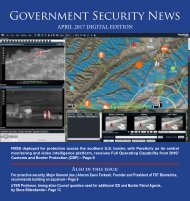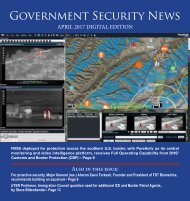GSN_Apr_FINAL+links
You also want an ePaper? Increase the reach of your titles
YUMPU automatically turns print PDFs into web optimized ePapers that Google loves.
Cubic executive to discuss benefits of cloud<br />
hosting at transportation summit<br />
JW Fishers describes equipment now<br />
used to locate weapons and explosives<br />
SAN DIEGO <strong>Apr</strong>il 27, 2017 Cubic<br />
Transportation Systems (CTS),<br />
a business unit of Cubic Corporation<br />
(NYSE:CUB), today announced<br />
Chris Bax, vice president of global<br />
ITS strategy, will participate<br />
in a panel discussion<br />
on the benefits of cloudbased<br />
technologies for traffic<br />
management systems<br />
at the ITS Heartland 2017<br />
Annual Meeting in Wichita,<br />
Kansas from May 1 – 3.<br />
Population growth is<br />
increasing the demands<br />
placed on roads and associated infrastructure<br />
around the world. Inevitably,<br />
pressure to expand and support<br />
transportation infrastructure growth<br />
is placed on the transit authorities<br />
that manage them. During the panel,<br />
Bax will cover “smart city” technology<br />
and how cloud hosting can be<br />
used to meet the needs of advanced<br />
traffic management solutions. He<br />
will highlight the benefits of cloudbased<br />
platforms, from integration<br />
capabilities to cost-effectiveness, resiliency<br />
and reliability. Additionally,<br />
Bax will address how cloud hosting<br />
is being applied, the long-term<br />
advantage and its ability to support<br />
Chris Bax<br />
smart cities.<br />
“Transportation infrastructure will<br />
constantly evolve in order to meet<br />
population growth,” said Bax. “It’s<br />
imperative for traffic management to<br />
be efficient now and in the<br />
future, as the only way we<br />
can maximize the lifetime<br />
performance of transport<br />
solutions is to rely on new<br />
technologies.”<br />
Bax will take part in the<br />
following panel session:<br />
Session 3A: Beyond the<br />
Signal – What’s New in Traffic Management<br />
and Operations<br />
Wednesday, May 3, 8:30 – 10:00 a.m.<br />
(local time); Riverview Ballroom,<br />
Hyatt Regency, Wichita, Kansas<br />
Moderator: Ron Hall, ITS Heartland,<br />
State Director, Kansas Department<br />
of Transportation (DOT); Panelists:<br />
Zach Hansen, SRF Consulting<br />
Group; Tom Hein, Kansas DOT;<br />
Brian Sovik, Data Transfer Solutions<br />
Follow Cubic Transportation Systems<br />
at @CubicTS or use the<br />
hashtags #THISisITS and #realITS<br />
to join the conversation. For updates<br />
or participation in the ITS Heartland<br />
conversation during the event, use<br />
the hashtag #ITSHeartland.<br />
About Cubic Corporation<br />
Cubic Corporation designs, integrates<br />
and operates systems, products<br />
and services focused in the<br />
transportation, defense training and<br />
secure communications markets.<br />
Cubic Transportation Systems is a<br />
leading integrator of payment and<br />
information technology and services<br />
to create intelligent travel solutions<br />
for transportation authorities and<br />
operators. Cubic Global Defense is<br />
a leading provider of live, virtual,<br />
constructive and game-based training<br />
solutions, special operations and<br />
intelligence for the U.S. and allied<br />
forces. Cubic Mission Solutions provides<br />
networked Command, Control,<br />
Communications, Computers,<br />
Intelligence, Surveillance and Reconnaissance<br />
(C4ISR) capabilities<br />
for defense, intelligence, security<br />
and commercial missions. For more<br />
information about Cubic, please visit<br />
the company’s website at www.cubic.<br />
com or on Twitter @CubicCorp.<br />
Before 1970 the widely accepted solution<br />
for disposal of old munitions,<br />
typically called unexploded ordnance<br />
(UXO), was to dump them<br />
into rivers, lakes and oceans. Today<br />
we know this creates a multitude of<br />
problems, the worst of which are<br />
pollution and the risk of an explosion.<br />
Many people have already<br />
lost their lives to these underwater<br />
booby traps. The uncertainties<br />
surrounding their precise location<br />
and degree of decomposition,<br />
makes attempting to recover these<br />
dangerous devices an even more<br />
difficult task.<br />
Several international organizations<br />
have been formed to address<br />
the problem of UXO on land<br />
and underwater, and a variety of<br />
tools and techniques are being<br />
employed to locate and remove<br />
them. One of the groups working<br />
the problem is the Japan Mine Action<br />
Service (JMAS), a non-profit<br />
engaged in humanitarian activities<br />
to create better and safer living<br />
conditions. Since its inception in<br />
2001, JMAS has implemented UXO<br />
clearance projects in a host of countries<br />
from Japan to Afghanistan. JW<br />
Fishers Pulse 12 boat-towed metal<br />
detector is assisting in these operations.<br />
The detector will locate both<br />
ferrous and nonferrous metals, an<br />
important feature as munitions<br />
can be made of a variety of metals<br />
including brass and steel. It’s large<br />
rectangular search coil can find<br />
metal buried up to 16 feet, and the<br />
Pulse 12 works equally well on land<br />
and in the water. With three detection<br />
heads attached to the master<br />
control console, an area up to 72<br />
feet wide can be swept in one pass;<br />
28 29<br />
saving time, fuel, and manpower. To<br />
inspect sites on land, the coil can be<br />
mounted on the front of an ATV or<br />
other vehicle allowing large areas to<br />
be swept quickly. This powerful machine<br />
is now helping a JMAS team<br />
uncover lethal UXO in Palau reports<br />
representative Terada Yasuo.<br />
Another organization using<br />
Fishers equipment in a similar operation<br />
is the Regional Centre for<br />
Underwater De-mining (RCUD)<br />
in Montenegro, which was part of<br />
the former Yugoslavia. A bloody<br />
civil war in the 1990’s left the<br />
country littered with unexploded<br />
ordnance and waterways unsafe to<br />
travel because of many scattered<br />
mines. After numerous fishermen<br />
and boaters were killed from these<br />
deadly devices, RCUD acquired a<br />
Fisher side scan to help locate the<br />
mines. The operation was a success.<br />
With the help of the sonar<br />
and trained divers, many explosives<br />
were found and removed<br />
from the country’s lakes and rivers.<br />
Today the sonar is being used for<br />
more peaceful purposes. RCUD is<br />
working in cooperation with RPM<br />
Nautical Foundation and the Center<br />
for Conservation and Archaeology















